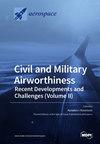翼尖链式飞机被动铰链振荡的空气动力学-结构耦合分析和风洞试验
IF 2.1
3区 工程技术
Q2 ENGINEERING, AEROSPACE
引用次数: 0
摘要
本研究考察了一种飞机概念中的机翼铰链振荡,这种飞机概念采用多个机翼或小型飞机,通过可自由旋转的铰链在翼尖形成链条,结构阻尼极小,没有机械位置锁定系统。这就产生了一种类似于垂直于飞行方向的飞行链的单个伪大跨度飞机。我们使用涡流晶格法和修改后的多连杆刚体摆方程进行了数值计算。计算结果与小规模风洞实验结果吻合。在风洞实验中,通过颜色跟踪对链翼的运动进行了跟踪,并使用六轴力传感器对力进行了测量。即使存在铰链连接振荡,链式机翼的总 CL/CD 也会增加。此外,假定无人驾驶飞机大小的数值模拟证实,在没有任何结构阻尼和完全依靠空气动力的情况下,理论上可以实现高链数机翼(≥9 个机翼)的被动稳定性。研究还获得了不同链翼数的适当铰轴角δ和攻击角区域指南,以最大限度地提高被动振荡稳定性。结果表明,翼尖链式飞机可以在保持灵活性、轻量化和CL/CD的同时,成功地提供较大的翼展,而不需要主动的铰链旋转控制。本文章由计算机程序翻译,如有差异,请以英文原文为准。
Coupled Aerodynamics–Structure Analysis and Wind Tunnel Experiments on Passive Hinge Oscillation of Wing-Tip-Chained Airplanes
This study examines the wing hinge oscillations in an aircraft concept that employs multiple wings, or small aircraft, chained at the wing tips through freely rotatable hinges with minimal structural damping and no mechanical position-locking system. This creates a single pseudo long-span aircraft that resembles a flying chain oriented perpendicular to the flight direction. Numerical calculations were conducted using the vortex lattice method and modified equations for a multi-link rigid body pendulum. The calculations demonstrated good agreement with small-scale wind tunnel experiments, where the motion of the chained wings was tracked through color tracking, and the forces were measured using six-axis force sensors. The total CL/CD increased for the chained wings, even in the presence of hinge joint oscillations. Furthermore, numerical simulations assuming an unmanned airplane size corroborated the theoretical attainment of passive stability with high chained numbers (≥9 wings), without any structural damping and relying solely on aerodynamic forces. Guidelines for appropriate hinge axis angle δ and angle-of-attack regions for different chained wing numbers to maximize passive oscillation stability were obtained. The results showed that wing-tip-chained airplanes could successfully provide substantially large wing spans while retaining flexibility, light weight and CL/CD, without requiring active hinge rotation control.
求助全文
通过发布文献求助,成功后即可免费获取论文全文。
去求助
来源期刊

Aerospace
ENGINEERING, AEROSPACE-
CiteScore
3.40
自引率
23.10%
发文量
661
审稿时长
6 weeks
期刊介绍:
Aerospace is a multidisciplinary science inviting submissions on, but not limited to, the following subject areas: aerodynamics computational fluid dynamics fluid-structure interaction flight mechanics plasmas research instrumentation test facilities environment material science structural analysis thermophysics and heat transfer thermal-structure interaction aeroacoustics optics electromagnetism and radar propulsion power generation and conversion fuels and propellants combustion multidisciplinary design optimization software engineering data analysis signal and image processing artificial intelligence aerospace vehicles'' operation, control and maintenance risk and reliability human factors human-automation interaction airline operations and management air traffic management airport design meteorology space exploration multi-physics interaction.
 求助内容:
求助内容: 应助结果提醒方式:
应助结果提醒方式:


